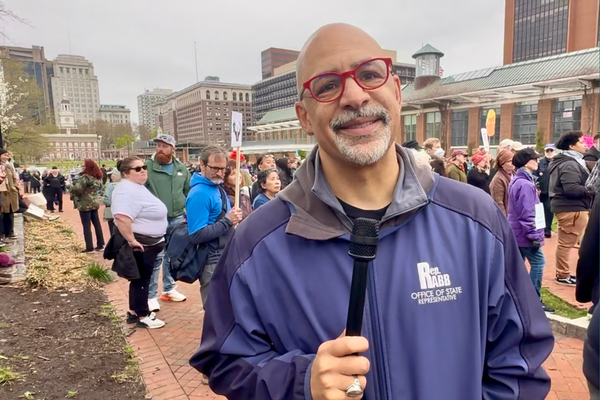How Big Tech Helps ICE Silent Dissent
Gatekeepers at Apple and Google prioritize fealty to Trump over the First Amendment and public safety

Editor's Note: A version of this post originally appeared at Tech Policy Press. We thank them for allowing us to reprint and update it here and urge you to subscribe to their newsletter.
Last week, Apple removed the mobile app ICEBlock and “similar apps” used by people in the United States to share information about nearby immigration enforcement operations from its App Store — reportedly following direct demands from the Trump administration.
ICEBlock allows people to crowdsource public information about immigration raids, described on its website as “Waze but for ICE sightings.” But according to an email sent from Apple to the app developer and provided to 404 Media, Apple decided that ICEBlock violates its policies against “Objectionable Content.” Apple told 404 Media in a statement that its determination was based on information “received from law enforcement about the safety risks associated” with the app.

In a statement to Fox News, which first reported the app’s removal, Attorney General Pam Bondi claimed that ICEBlock “is designed to put ICE agents at risk.” In June, Department of Homeland Security Secretary Kristi Noem told reporters that she’d asked the Department of Justice to look into prosecuting CNN for reporting on ICEBlock on the basis that the app “is actively encouraging people to avoid law enforcement activities and operations.”
Despite the inconsistent justifications, the throughline is clear: the Trump administration has set its sights on anyone monitoring its expanding immigration enforcement operations, and it’s turning to major tech companies to help. In early September, DHS sent an administrative subpoena to Meta demanding information about several Instagram accounts, including StopICE.net — which similarly crowdsources information about immigration raids. A federal judge has temporarily blocked Meta from sharing that information.
Given the dominance of their respective app stores, Apple and Google both have an unusual degree of control over the content people can access through their phones. While removing ICEBlock from the Apple App Store does not immediately prevent those who have already downloaded the app from using it, it effectively prevents new users from accessing the app, and it will prevent the app developer from updating it to ensure continued functionality and security. ICEBlock was never available on Google Play, but Google confirmed to 404 Media that it has removed other ICE-spotting apps from its store.

More takedowns
Since I first published this article at Tech Policy Press, Apple has only doubled down on its moves to shield ICE. Internal emails obtained by the newsletter Migrant Insider show the company also removed DeICER, an app developed by a former Syracuse University journalism professor that collects reports of immigration enforcement activities. The removal came “after a law enforcement complaint — invoking a rule normally reserved for protecting marginalized groups from hate speech.”
As Migrant Insider explains: “A guideline written to protect minorities from hate speech is now being used to protect federal agents from public accountability.” Google provided a similar justification to 404 Media, claiming that it removed apps “that share the location of what it describes as a vulnerable group after a recent violent act against them connected to this sort of app.” Neither Apple nor Google has offered any examples of these apps being used to harm federal agents.

Further indispensable reporting by 404 Media found that Apple had taken down Eyes Up, an app designed to preserve videos documenting ICE abuses. “Our goal is government accountability, we aren’t even doing real-time tracking,” the Eyes Up administrator said. “I think the [Trump] admin is just embarrassed by how many incriminating videos we have.”

This is not the first time Apple and Google have been pressured to flex their power as an infrastructural bottleneck. In 2019, following pressure from the Chinese government, Apple removed an app that pro-democracy activists in Hong Kong used to crowdsource information about police activities. Google and Apple both removed an app built to coordinate protest votes against Russian president Vladimir Putin in 2021, after Russian authorities designated Putin’s core opposition as extremists.
It’s not just social media
It’s hard to see how crowdsourcing information on ICE operations is easily distinguishable from live reporting — an activity explicitly protected by the First Amendment. But it doesn’t seem like the Trump administration has any interest in making that distinction as it moves to ban and chill traditional media reporting on the topic, too.
Earlier this year, the Trump-appointed chairman of the Federal Communications Commission, Brendan Carr, opened an investigation into a local radio station over its reporting on local ICE operations. As he’s done in other threatened investigations of media, Carr cited no law or rule or other precedent the station had violated, claiming only that reporting on ICE raids is somehow inconsistent with broadcasters’ “public interest” obligations.
In June, Emmy award-winning reporter Mario Guevara was detained while live-streaming a “No Kings Day” protest in Atlanta. While the charges leading to Guevara’s arrest at the protest were quickly dropped, he was immediately transferred to ICE custody. Last Friday, after over 100 days in immigration detention, he was deported to El Salvador.
ICE is the real public-safety risk
Apple and Google face no legal obligations to comply with the Trump administration’s demands to remove ICE-spotting apps, much less to echo plainly disingenuous narratives when faced with a transparent campaign to target and chill information-sharing about ICE operations.
There are certainly “safety risks” surrounding the ongoing raids. Federal immigration agents are dragging children out of their homes in the middle of the night, throwing journalists to the ground in courthouses, and expanding their own capabilities to harvest location data directly from people’s phones and target people for deportation based on their social media posts.

Meanwhile, the Trump administration has no qualms about sharing its own highly-produced videos of these operations — including reels featuring people who are half-dressed after having been pulled out of their beds by federal immigration agents, like the one DHS posted to social media in the aftermath of an apartment building raid in Chicago earlier this week.

Flashbang grenades, drones, and armed men rappelling onto the roof from Black Hawk helicopters were all part of a deployment of resources and show of force grossly disproportionate to storming an apartment building filled with families in the dead of night, but well-suited to a dramatic social media reel captioned: “Darkness is no longer your ally. We will find you.”
About the author
Jenna Ruddock supports Free Press’ policy, legal and communications work across issue areas, with a focus on technology, surveillance, digital civil rights and dissent. Follow Jenna on Bluesky.
Open tabs
The Institute for Nonprofit News (INN) just published its annual index on the state of nonprofit news organizations in the United States. While there are many challenges — including devastating cutbacks to public media funding — the sector is growing, employing more than 4,600 people, mostly in news and editorial roles.

Notably, as Nieman Lab reports, “nonprofit news outlets of all types are enjoying revenue growth — but those that focus specifically on local news, rather than state, national, or global news, are doing especially well.”
In a meeting with journalists last month, Pope Leo XIV proclaimed: “Information is a public good that we should all protect. For this reason, what is truly productive is a partnership between citizens and journalists in the service of ethical and civic responsibility. One form of active citizenship is to value and support professionals and agencies that demonstrate seriousness and true freedom in their work. This creates a virtuous circle that benefits society as a whole.”

That’s right, the Holy Father understands that journalism is a public good. And he has a message for journalists (and their bosses, too). “With your patient and rigorous work, you can act as a barrier against those who, through the ancient art of lying, seek to create divisions in order to rule by dividing,” he said. “You can also be a bulwark of civility against the quicksand of approximation and post-truth.… I urge you: never sell out your authority!”
Can we get an Amen?
The kicker
You can be the president, we'd rather be the...













